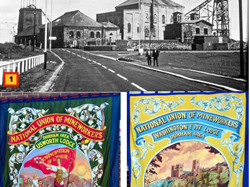Collieries
Usworth Colliery
The colliery was owned by by John Bowes and Partners, who began to sink the first shaft on 7th April 1845. The first coal seam reached was the Maudlin seam, at a depth of 213 yards, and over the years the shaft was deepened, and further coal seams worked, including the Hutton, Low Main, Beaumont, Busty, Brockwell, Tilley and Harvey seams. At it's peak in 1921 the colliery employed 1785 men and boys.
In 1863 the company erected Usworth Colliery School, with accommodation for 600 children; and in 1891 the Miners Hall was built, containing a lecture hall, billiards reading and committee rooms and a caretakers house. Apart from the many accidents involving individuals there were two major mining disasters - in 1850, when an explosion caused by a naked flame killed 13 men; and in 1885 a gas explosion caused by shot-firing killed 42 men.
In 1959 the colliery was linked with Wardley colliery via an underground roadway, and from 1969 all coal was raised from Wardley, with Usworth being used only for access for the miners.
When the colliery closed on 1st August 1974, 839 men lost their jobs. During the building of new roads and houses when Washington New Town was being built all traces of the colliery disappeared.
Washington Colliery
The colliery was owned by William Russell and Partners and was made up of eight pits, spread across the area, and given letters for names, from A pit to I pit. The pit last in production was the F Pit, which was probably sunk in 1777. In 1796 it had to be abandoned following an explosion, and a new F pit was sunk nearby in 1820.
Seams worked included the Maudlin, Hutton, Low Main and Busty. Production levels were greatest in 1964/65 when 468,000 tons of coal were sold, and more than 1500 men were employed. The last coal was drawn to the surface on 21 June 1968.
Over the years there have been around 150 fatalities in the mine. Recorded disasters, with 5 or more fatalities are:
- 14 June 1776 -5 killed.
- 12 February 1796 – 6 killed.
- 27 February 1798 -7 killed.
- 20 November 1828 -14 lives lost in an explosion.
- 19 August 1851 -34 lives lost in an explosion caused by a lighted candle.
- 31 May 1867 – 8 men and two boys were killed when a brakeman failed to stop the cage as it reached the top of the shaft. The cage hit the stops near the pullies and the rope broke causing the cage to fall 750 feet to the bottom of the shaft.
Although the colliery is now closed, the winding house and head gear pit was presented to the people of Washington by the NCB as a memorial to coal mining in the area. A museum was opened 1976 by Washington Development Corporation and is now owned by Sunderland City Council.
Harraton Colliery
The colliery was situated on Vigo Lane, near to where Rickleton Primary School now stands. It is known that coal mining took place in the area from the 17th century, when coal would have been loaded onto keel; boats on the nearby River Wear. Owners of the pit included Messrs Lamb and Co, Stobart Bell and Coin the 1850s and Lambton Collieries in the 1890s.
Seams worked included the Hutton, Maudlin, Brass Thill. Five Quarter, Main, and Low Main seams.
Durham Mining Museum records the names of 138 fatalities in the pit during it's life. Major accidents occurred;-
- in 1794 when there was an explosion which claimed 28 lives;
- in 1808 at least 4 men were killed in an explosion;
- in 1817 38 lives were lost in an explosion and
- in 1817 8 lives were lost due to Choke Damp.
A small village called “Nova Scotia” was the site of Harraton's Row Pit, where the 1817 disaster took place. The area is now the General's Wood area of Washington New Town.
At it's peak, in 1955, the colliery employed 1533 men and boys. The colliery ceased operating in 1965.
Springwell Colliery
Whellan's 1894 Directory of County Durham states that - “Springwell Colliery is also the property of John Bowes & Partners, working the Main Coal at a depth of 94 fathoms, with a thickness of 3feet 4 inches; the Maudlin, 105 fathoms, 5 feet 6inches; Low Main, 155 fathoms, 3 feet;and the Hutton, 125 fathoms, worked out. There are about 700 men employed, and the output has reached 1000 tons.”
It is difficult to find details of individual deaths, but recorded disasters are:
- 9 May 1833 - Explosion , 47 lives lost.
- 6 December 1837 – Explosion, 27 lives lost.
- 29 January 1869 – Explosion, 5 lives lost.
Springwell Colliery closed in June 1932 and the buildings were converted into railway workshops. Bowes Railway Museum which now occupies the site, was originally a colliery railway linking Springwell and nearby Mount Moor (Black Fell) collieries to Jarrow Staithes, where the coal was loaded onto ships. The original 1826 section of the railway, running from Black Fell bank head to Springwell was acquired for preservation by Tyne & Wear County Council in 1976. It is the only working preserved standard gauge rope hauled railway in the world. In 1977 the railway's engineering and wagon shops on the former colliery site were added to the scheme, providing facilities for maintenance. The colliery winding gear and associated buildings have been demolished.
From the Top:
1. Usworth Colliery
2. Usworth
3. Washington
4. Washington Colliery
5. Harraton Colliery
6. Harraton
7.Springwell
8.Springwell Colliery
More Pits to Follow.................................
©Washington History Society
LOOK OUT FOR MORE ARTICLES HERE SOON
Why not contribute to our archive?
Send your articles to the address below.

